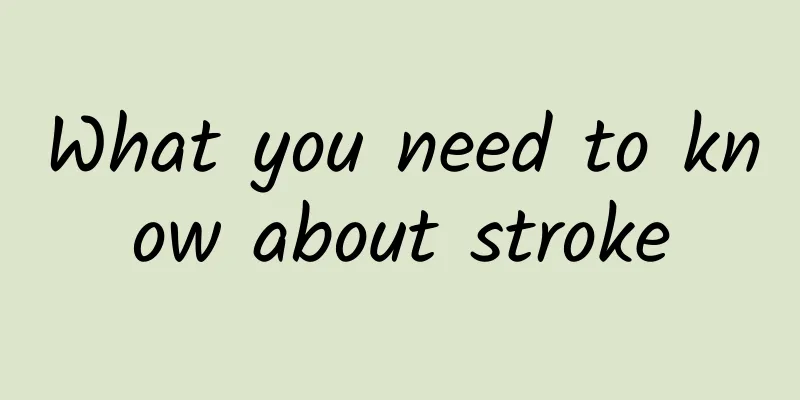What you need to know about stroke

|
What is a stroke? Stroke, commonly known as "stroke", is an acute cerebrovascular disease. It is a group of diseases that cause brain tissue damage due to sudden rupture of brain blood vessels or blockage of blood vessels that prevent blood from flowing into the brain. It is usually divided into two categories: ischemic and hemorrhagic. Ischemic stroke, also known as cerebral infarction, is caused by stenosis or blockage of cerebral arteries, leading to cerebral ischemia and hypoxia, accounting for more than 80% of strokes. Hemorrhagic stroke, also known as cerebral hemorrhage, is caused by rupture of a brain artery, which causes blood to seep into or accumulate inside or outside the brain tissue. It accounts for about 20% of strokes. What are the dangers of stroke? Stroke has the "five highs" characteristics of high incidence, high recurrence rate, high disability rate, high mortality rate and high economic burden. It is one of the major chronic non-communicable diseases that threaten national health. Stroke has an acute onset and rapidly progresses, which can lead to limb paralysis, language disorders, dysphagia, cognitive impairment, depression, etc., seriously affecting the patient's quality of life and placing a huge burden on their families and society. Stroke is the leading cause of death in China. More than 1.9 million people die from stroke each year. The standardized incidence of first stroke in residents aged 40 and above increases by an average of 8.3% per year. The standardized prevalence of stroke in residents aged ≥40 years increased from 1.89% in 2012 to 2.32% in 2018, and it is estimated that there are 13.18 million people with stroke in residents aged ≥40 years. There is also a clear trend of stroke becoming younger. According to statistics, the incidence of ischemic stroke in the young and middle-aged population aged 25 to 44 in my country is 34.5 cases per 100,000 population, and the incidence of hemorrhagic stroke is 12.7 cases per 100,000 population. What are the risk factors for stroke? Stroke is preventable and treatable. Interventional risk factors include hypertension, diabetes, dyslipidemia, atrial fibrillation, smoking, alcohol intake, unreasonable diet, overweight or obesity, lack of exercise, psychological factors, etc. Hypertension is the main cause of ischemic and hemorrhagic stroke. Controlling blood pressure can reduce the risk of ischemic stroke by more than 50% and hemorrhagic stroke by more than 40%. Diabetes can cause arteriosclerosis and microcirculation disorders, increasing the risk of ischemic stroke by 2 to 4 times. Dyslipidemia can promote the formation of atherosclerosis and increase the risk of ischemic stroke by 1.5 to 2 times. Atrial fibrillation is the most common cause of cardioembolism and increases the risk of ischemic stroke by more than 5 times. Smoking can damage endothelial cells, increase atherosclerosis and coagulation tendency, and increase the risk of ischemic and hemorrhagic stroke by 1.5 to 3 times. Excessive alcohol intake can cause hypertension, arrhythmias and coagulation abnormalities, and increase the risk of ischemic and hemorrhagic stroke by 1.5 to 3 times. An unreasonable diet can lead to nutritional imbalance and excess energy, increasing the risk of metabolic disorders such as high blood pressure, high blood sugar, and high blood lipids. Being overweight or obese increases myocardial oxygen consumption and cardiac output, and increases the risk of metabolic disorders such as hypertension, hyperglycemia, and hyperlipidemia. Lack of exercise can lead to weight gain and decreased cardiopulmonary function, increasing the risk of metabolic disorders such as high blood pressure, high blood sugar, and high blood lipids. Psychological factors such as stress, depression, and anxiety can affect the balance of the neuroendocrine system and the autonomic nervous system, increasing the risk of cardiovascular events such as hypertension and arrhythmia. How to do self-assessment and screening? The simple and easy "8+2" scoring method is used to assess whether an individual has or has experienced "8" major and "2" minor conditions. "8" refers to high blood pressure, dyslipidemia, diabetes, smoking, atrial fibrillation, overweight or obesity, and lack of exercise. "2" refers to high homocysteine and high-sensitivity C-reactive protein, both of which are related to atherosclerosis and inflammatory response, and are also risk factors for stroke. Each risk factor has a corresponding score. The higher the score, the greater the risk of stroke. The specific scoring method is as follows: If your score is above 3 points, it is recommended that you go to the hospital regularly for professional screening and evaluation, as well as necessary intervention measures. How to provide first aid for stroke? Stroke is a disease that requires emergency treatment. Time is life and time is brain. If you can reach the hospital and receive thrombolytic therapy within 4.5 hours after the onset of the disease, the patient's survival rate and quality of life can be significantly improved. Therefore, we must learn to recognize the signs of stroke and call 120 for help in time. According to the internationally accepted BEFAST rule, we can determine whether a stroke has occurred through the following six aspects: B (Balance): Is your balance out of balance? Do you feel dizzy, unsteady, or wobbly when walking? E (Eyes): Is your vision blurred? Is there any blurred vision, dark shadows, or visual field loss in one or both eyes? F (Face): Is the face crooked? Is there weakness on one side of the face, crooked corners of the mouth, asymmetrical smile, etc.? A (Arm): Is your arm weak? Is one arm weak, unable to lift, or drooping? S (Speech): Is there a language barrier? Is the patient speaking unclearly, incoherently, or unable to understand what others are saying? T (Time): Time is life. If any of the above symptoms occur, please call 120 immediately and tell the ambulance staff that it may be a stroke. While waiting for the ambulance to arrive, we can also do some simple first aid: Keep the patient quiet and avoid emotional excitement or strenuous activity. Ask the patient to take a comfortable position, usually a semi-sitting or side-lying position, with the head slightly raised to keep the airway open. Untie the patient's tie, collar and other restrictive clothing, and keep the clothing moderately loose. Clear food, saliva and other foreign objects from the patient's mouth to prevent aspiration or suffocation. Observe the patient's state of consciousness, breathing, skin color and other vital signs, and be ready to perform cardiopulmonary resuscitation at any time. Do not feed water or medicine to the patient to avoid aggravating the condition or causing aspiration. Do not massage the patient's limbs or acupoints at will to avoid dislocation of blood clots or aggravation of bleeding. Do not use folk remedies or folk medicines blindly to avoid delaying the best time for treatment. Summarize Stroke is a common and serious cerebrovascular disease that brings huge physical, psychological and economic burdens to patients and their families. We should pay attention to the prevention and intervention of stroke, control our own risk factors, and develop a healthy lifestyle. At the same time, we must also learn to recognize the signs of stroke and master the correct first aid methods to strive for the golden time for rescue and improve the survival rate and quality of life of patients. |
<<: Diabetes at a young age is caused by these lifestyle habits! Be careful at all ages
>>: Is a low glycemic index diet the “gold medal for preventing obesity”?
Recommend
Avocado - the most nutritious fruit in the Guinness World Records
Author: Cui Yihui, registered dietitian Reviewer:...
The world's first shot!
On May 1, the clinical study of the inactivated C...
What should graduates pay attention to when they go to work for the first time? Should new employees in the workplace be completely obedient?
After a successful interview, you will need to re...
After quitting drinking, my body experienced 5 changes. After reading them, I made an important decision
There are many people who love to drink, and ther...
What is adenomyosis?
Uterine diseases account for the vast majority of...
What is the disease of sweating on the female chest?
Some female friends tend to sweat a lot in the fr...
Threatened abortion bleeding chart
Threatened abortion, traditionally known as "...
Does confinement mean continuous bleeding?
There will be continuous bleeding in the first we...
What to do if a woman has hydrosalpinx
Many women experience hydrosalpinx, or more corre...
Is mild cervical erosion serious?
Many women are very worried after being diagnosed...
Can I eat rice crust during menstruation?
In fact, rice crust is burnt rice, but the taste ...
How big is the uterus for adenomyosis and does it require surgery?
During the treatment of adenomyosis, the surgical...
What are the causes of breast lymph node lumps?
The breast is a very important organ in the femal...
How to increase prolactin secretion?
Prolactin is a hormone secreted by the human mamm...
What is the problem with yellow cucumber leaves? How to solve the problem of yellow cucumber leaves
Cucumber is a common vegetable in life. Because i...








![[Medical Q&A] How to identify the early symptoms of Alzheimer's disease?](/upload/images/67f0e691316a8.webp)
